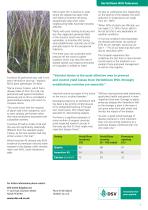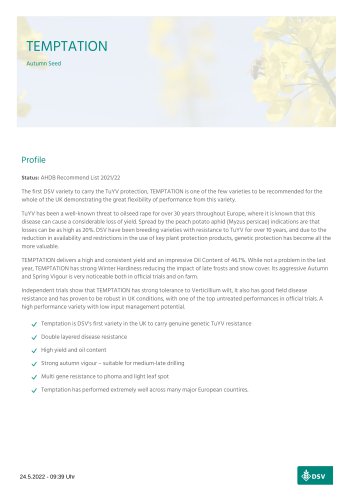
Catalog excerpts

Verticillium Wilt Tolerance Latest Adas Trials Highlight Importance of Verticillium Wilt Tolerance Results from 2017 ADAS trials are underlining the importance of selecting varieties with strong tolerance to Verticillium Wilt. With resulting yield losses of up to 25% experienced in mainland Europe, Verticillium Wilt has yet to have a major impact on UK production but many believe it’s only a matter of time. With very little in the way of agronomic control options available, mitigating the potential effects of the disease lies on the shoulders of plant breeders to develop varieties with acceptable levels of tolerance to it. “We’ve actually seen the disease in the UK since 2007 and it’s been a worry for many growers with some years being worse than others,” explains Sarah Hawthorne of plant breeders DSV. Over recent years, various trials have taken place to try and identify which plants are the most affected, Sarah Hawthorne explains. “It’s one of those diseases which is difficult to spot until it is too late but it’s highly likely that it has been behind much of the production variability we have seen in recent years.” Infection with the pathogen Verticillium Longisporum starts at the seedling stage with carry over of the causal agent in the soil, plant debris or farmsaved seed often being the reason, she explains. “Once plants are infected, the disease spreads up through the xylem at stem extension before the first symptoms appear as the plant ripens. “This late visibility of the disease is one of the main reasons it is so difficult to manage – by the time you see it, it’s too late – but the impact of the disease can be considerable.” “Claims of resistance are misleading as all varieties will suffer from Verticillium Wilt to some degree in the right circumstances – but whilst some will suffer minimal damage, others can be devastated. “What is interesting is the consistency of results achieved over the last five years of trials in different growing conditions. Showing tolerance to Verticillium Wilt is very much a key genetic characteristic of some varieties over others.” The hybrid variety Incentive 45 has been the stand-out variety in trials and this has been re-iterated in the latest
Open the catalog to page 1
"We've seen this in practice in areas where the disease has taken hold with fields of Incentive 45 being exceptionally clean even when neighbouring fields have been severely affected. "Plants with poor rooting structures and less than aggressive growing habits in the Autumn tend to be the most vulnerable, so Incentive 45's strong early establishment could be one of the principle reasons for this exceptional tolerance. "The three crop rule could take some pressure off the move to tighter rotations which may slow the rate of disease spread, but ongoing revocation of fungicides is unlikely to...
Open the catalog to page 2All DSV UK catalogs and technical brochures
-
Spring Oilseed Rape
6 Pages
-
SENDERO
2 Pages
-
ARMAN
2 Pages
-
DART
1 Pages
-
MIRACULIX CL
3 Pages
-
PINACO
3 Pages
-
LOXTON
2 Pages
-
BEATRIX CL
3 Pages
-
DUKE
2 Pages
-
DOLPHIN
2 Pages
-
DEVIL
2 Pages
-
CROCODILE CR
3 Pages
-
EXPEDIA
3 Pages
-
Darling
3 Pages
-
LAGONDA
2 Pages
-
LUMEN
2 Pages
-
MENTHAL CR
2 Pages
-
THEODORE
4 Pages
-
LIROYAL
5 Pages
-
INCENTIVE
2 Pages
-
CLICK CL
2 Pages
-
OLYMPUS
2 Pages
-
MOVANNA
3 Pages
-
LIKEIT
5 Pages
-
PLURAX CL
2 Pages
-
Temptation
3 Pages
-
Product Guide
27 Pages
-
TerraLife
6 Pages
-
Harvest Update
1 Pages
-
Clearfield
2 Pages
-
BetaMaxx DT
1 Pages
-
Dualis
1 Pages
-
Dariot
2 Pages



































